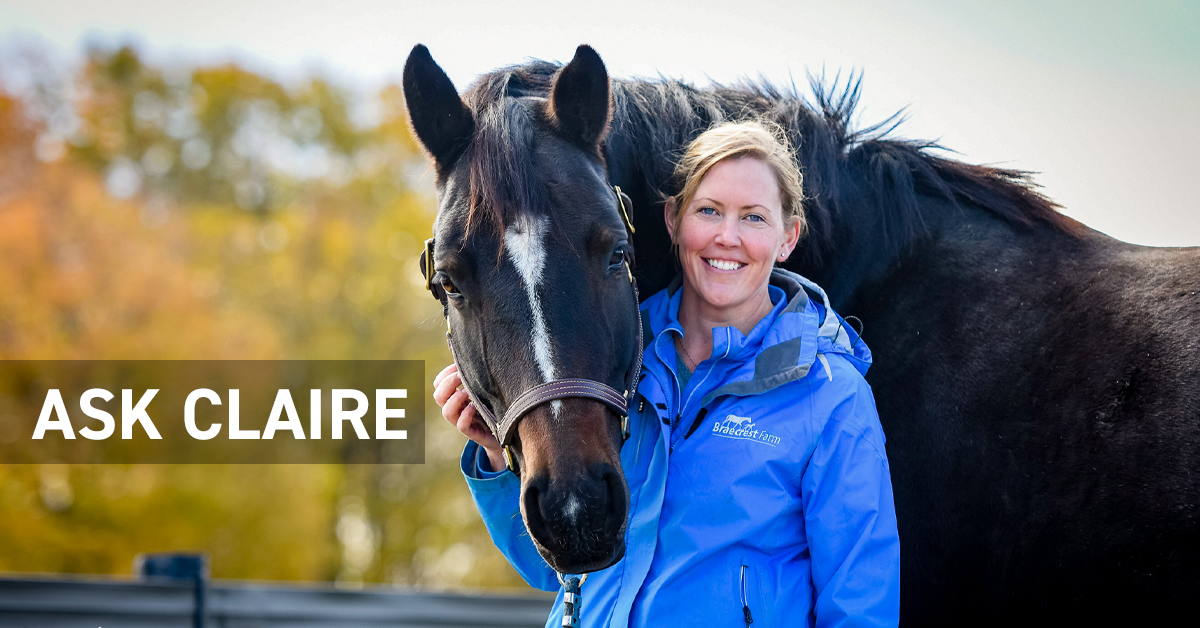CLAIRE,
WHAT STEPS DO YOU TAKE TO PREPARE YOUR WEANLINGS FOR SHOW? THE TWO THAT YOU TOOK THIS FALL TO THE QUALIFIER LOOKED SO CALM, AND I’M HOPING TO LEARN HOW TO MAKE THOSE EXPERIENCES AS STRESS-FREE AS POSSIBLE. THANK YOU. K&E
Hi, K & E; I am combining your questions because they are similar. This is what I recommend when preparing babies for showing.
AGE
It’s crucial that foals that are being shown are either still with the support of their dam or weaned at an appropriate age. Weaning too young just to show is a bad idea and can cause a lifetime shadowed with anxiety. At Braecrest Farm, we consider weaning anywhere from 4-8 months, depending on the development of the foal, both mentally and physically.
HALTER TRAINING
We begin haltering our foals from 24 hours old. However, for the first 4 weeks minimum, we lead with a rope around their body, being very careful never to pull on their necks. Gently, over time, we work on teaching them to soften to pressure and follow a feel. At around 4 months, we start teaching them to jog in hand. I like to use a dressage whip to touch their hindquarters gently, and we use a voice command (usually a ‘click.’). They learn that when I “click,” it means to push from behind and move up, either to a faster walk or trot. While working in hand, I teach them to match my steps. A fast walk, slow walk, slow trot, and open trot teach them to stay connected with me, reading my body language and adjusting their pace.
We show our foals in a quality leather halter and leather lead with no chain. My preference is a 3/4” width leather halter and no throat latch clip – since it is too distracting.
DEVELOP INDEPENDENCE AND CONNECTION WITH PEOPLE
We are very careful to work in stages with building independence. Respecting their natural needs for social support and learning within a herd is crucial in the early days. From the day they are born, we are also casually working on helping them see value in people, building trust and connection, and showing them we can be leaders for them. Being a leader gives them tremendous trust and value in us, which helps them become agreeable and willing and have so much ‘try.’ It is imperative that they are never overwhelmed with too much too soon and never ‘flooded’ with frightening stimuli. They should be slowly brought along so they understand life, learn emotional control, and how to self-soothe when things in our human world trigger them. Give them time to think, process, and choose safe and reasonable reactions.
PRACTICE ELEMENTS OF THE DAY AHEAD OF TIME
I like to think of each task they must do on show day and work on each task individually ahead of time, with no pressure or time constraints. Learn about bath stall one day, trailer loading a different day, grooming and playing with braiding the mane to get them used to all the different sensations. If you break down all these elements and build confidence in each area, then when you have to ask for those tasks all in one day, it is not as overwhelming for them.
GROOMING
From the early days, we like to spend a little time here and there teaching them about brushing, picking feet, getting them used to sprays and towels etc. Again, if this is done slowly ahead of time, on show day, it is just the ‘norm,’ and it is no longer a trigger.
HEALTH CHECK
Before considering showing, you want to be sure that your baby has the best protection for their health. Are they in good weight and condition before asking them to do something stressful? We like to connect with our Equine Nutritionist, Laurie Bishop, from Brooks Feeds. Laurie ensures that every nutritional need is met at Braecrest, from in-utero to mature horse. Concerning the immune system, did the dam get her pre-foaling shots so the foal has some protection against different viruses and diseases? Once your foal is old enough, we like to administer an inter-nasal flu/rhino vaccine a few weeks before show day. It is best to discuss this with your veterinarian and what is the most suitable for your foal
HAVE A QUESTION FOR CLAIRE? SUBMIT ONE HERE!






Leave A Comment